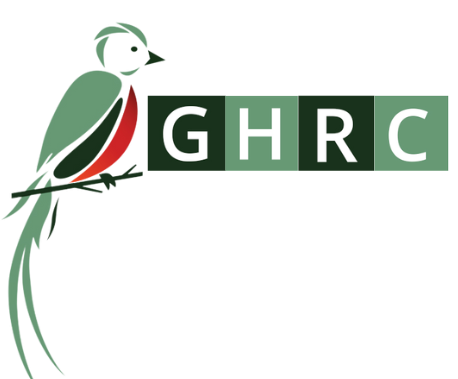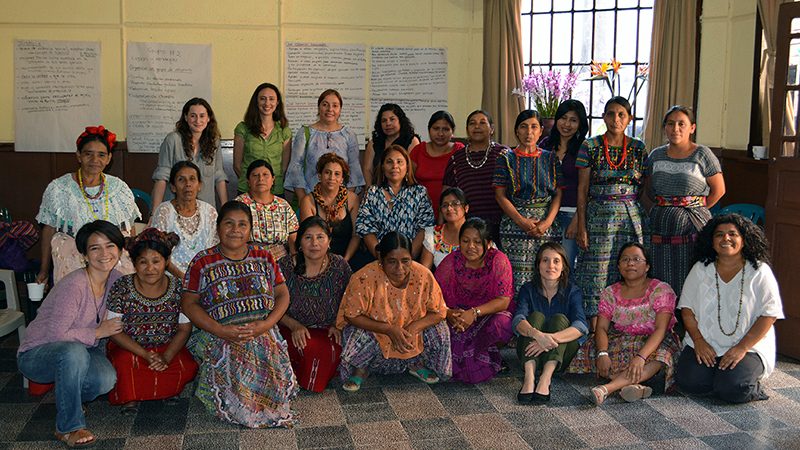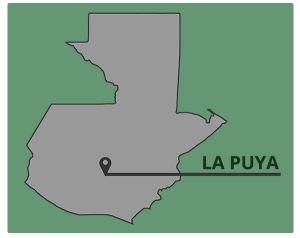Since March 2, 2012, residents from around the proposed site of the El Tambor Mine had maintained a peaceful, 24-hour blockade at the entrance to the mine, which is owned by the Reno-based engineering firm Kappes, Cassiday & Associates (KCA).
Residents are concerned about the health and environmental impacts of the mine and they are committed to defending their right to be consulted — as required under national and international law — about projects in the community that would affect their lives and livelihoods.
On May 23, 2014, after two years of peaceful struggle, the communities in resistance of La Puya were violently evicted from the entrance to the project; at least 20 people were injured and 7 were taken to the hospital in Guatemala City. Since then, the Guatemalan police and military have escorted mining equipment onto the site.
The brave men and women of La Puya have not backed down, and continue to oppose the project. On July 15, 2015, a Guatemalan court ruled in favor of La Puya, ordering EXMINGUA — the Guatemalan subsidiary of US mining company Kappes, Cassiday & Associates (KCA) — to suspend all activities at the mine until a community consultation is held. The court also ordered the Municipal Council of San Pedro Ayampuc to take action to ensure any construction is stopped within the next 15 days.
The ruling was appealed by EXMINGUA, but upheld by Guatemalan courts. Despite the injunction, however, the company has continued operations as though nothing has occurred. On October 26, 2015, 12 members of the US Congress sent a letter to President Alejandro Maldonado Aguirre to raise concerns about abuses related to the El Tambor gold mine, and to call for KCA and EXMINGUA to promptly halts the illegal operations.
In February 2016, the Guatemalan Supreme Court ruled to provisionally suspend the mining license due to lack of prior consultation.
Click here to read GHRC’s four-page report on La Puya, published in November 2014. The report is also available in Spanish here.
| HISTORY OF LA PUYA | RECENT UPDATES | MULTIMEDIA & OTHER RESOURCES |
SIGN ON TO A SOLIDARITY LETTER FOR THE PUYA’S 4TH ANNIVERSARY CELEBRATION! |
RECENT UPDATES:
APRIL 22, 2016 | Ministry of Energy and Mining (MEM) files a criminal complaint against Exmingua, a subsidiary of KCA.
April 14, 2016 | MEM verifies the company’s lack of compliance and declares it will initiate sanctions
March 10, 2016 | The MEM enforces the Supreme Court ruling by suspending the mining license.
FEBRUARY 25, 2016 | GHRC Press Release: Guatemalan Supreme Court Suspends KCA’s mining license
NOVEMBER 12, 2015 | GHRC Press Release: US Congress to Guatemalan President: Halt Illegal Mining Operations at La Puya
JULY 17, 2015 | GHRC Blog: Victory for La Puya: Guatemalan Court Orders Suspension of Construction Operations at the El Tambor Mine
MULTIMEDIA AND OTHER RESOURCES:
Click here to read the GHRC report (Feb. 2014) : The Peaceful Environmental Justice Movement at La Puya
Click here to watch a video about La Puya: The La Puya Peaceful Resistance Movement to the El Tambor Mine
VIEW A HISTORY OF THE MOVEMENT:
Since 2010, the communities of San José del Golfo and San Pedro Ayampuc have denounced the imposition of a gold mine without community consent. The proposed mining project, first owned by Canadian company Radius Gold and later sold to US Engineering firm Kappes, Cassiday & Associates (KCA), has received a dozen mining licenses for exploration and extraction over an area of 20 square kilometers. After Radius Gold acquired the land, almost a decade passed while experts tested different locations for gold without the communities’ knowledge.
2010: When the communities learned through a news article that a mine would be built, affecting thousands of families, many were outraged. Residents attempted to get information from different government agencies, but were either ignored or directly lied to about the status of the mining project.
MARCH 1, 2012: Community member Estela Reyes decided to block the entrance to the Canadian-owned Tambor gold and silver mine to prevent trucks, excavators, and other mining equipment from entering the communities.
MARCH 2, 2012: Community members of San Pedro Ayampuc and San José del Golfo joined Estela and transformed the roadblock into a community-based, peaceful resistance movement. It was the beginning of the Communities in Resistance, or the “Puya,” as the human blockade has come to be known. The community members settled into shifts of 24 hours a day, 7 days a week. Some donated food, others volunteered by cooking; some came for 12 hours at a time, others came after work. Men, women and children have spent over two years blocking the entrance to the proposed mine.
The Communities in Resistance are concerned about the mine’s health, social, and environmental impacts. They maintain that the government has not complied with legal obligations to consult with communities about projects that would affect them. They were not given the opportunity to read and submit comments on the mining company’s environmental impact assessment. The community wants the government to hold a referendum on the opening of the mine.
Director of Mines, Selvin Morales, who approved the mining licenses, has since become the General Manager of KCA’s Guatemalan subsidiary, EXMINGUA. The mining company expects to process approximately 150 tons of material per day from at least 3 separate extraction sites, using both open pit and tunnel mining. In an already dry region, where families sometimes only have access to fresh water twice a week, the mine would use 155 cubic meters of water per day – approximately equivalent to the amount one family would use in a year. The company’s environmental impact assessment recognized that air quality would be affected, as well as flora, fauna, top soil, and the available quantity of water. It is unclear where the company plans to treat or dispose of chemical “tailings” and what impact this will have on the local water and soil.
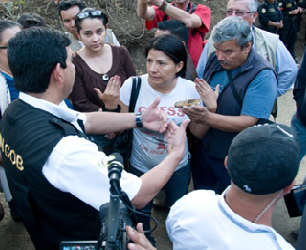 |
| Yolanda Oqueli negotiates with the Interior Ministry during a tense confrontation |
MAY 8, 2012, 1 AM: The mining company, backed by 400 riot police in 50 trucks, attempted to break the blockade at La Puya. The late-night siege aimed to bring mining machinery into El Tambor, the proposed mining site. Hundreds of residents stood in front of the police and machinery, denying them passage. The police and mining vehicles ultimately turned around.
JUNE 13, 2012: At approximately 6:30pm, Yolanda Oqueli, an anti-mining activist from San José del Golfo, was shot in the back by two men on a motorcycle while leaving her shift at the blockade. Prior to the attack, Yolanda and other anti-mining activists had received threats and acts of intimidation. Days before the shooting, they had presented a formal complaint to the Public Prosecutor’s Office. The attack has still not been fully investigated, and no one has been held accountable.
Numerous delegations have visited the communities in resistance, including three with GHRC. GHRC responded immediately to the attempted assassination of Yolanda Oquelí with a public statement and a petition. The petition called on the Guatemalan government to investigate the crime and prosecute those responsible. Moreover, GHRC called on the Guatemalan government to guarantee the safety of community members of San José del Golfo and San Pedro Ayampuc and to find a solution to the conflict that prioritizes the needs and rights of the Guatemalan people over the interests of international corporations. GHRC delivered the petition with over 700 signatures to members of Guatemalan and US authorities.
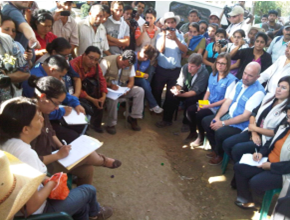 |
| A “dialogue table” was called at the site of the roadblock including government representatives, community members, and human rights defenders. Photo: Radio Punto |
NOVEMBER 13, 2012, 10AM: Approximately 80 people from San José del Golfo and surrounding municipalities wearing EXMINGUA hard hats and shirts tried to force their way into the mine demanding their right to work. Hoping to open the door for intervention from public and private security forces, the mine personnel attempted to provoke the population. As news spread about the confrontation, the number of those in peaceful resistance to the mine grew to an estimated 500 people. About 16 members of the National Civil Police (PNC) were also on the scene. Attempts at dialogue facilitated by representatives of the Presidential Commission for Human Rights (COPREDEH) and the Human Rights Ombudsman (PDH), as well as national and international organizations, failed.
Throughout late November and early December, people hired by the mining company continued to harass and threaten the peaceful protestors and their supporters.
DECEMBER 7, 2012, 6AM: Anti-riot police arrived at the roadblock and began tearing down the banners and temporary kitchen. The Communities in Resistance laid down on the street as the police attempted to forcibly evict them.
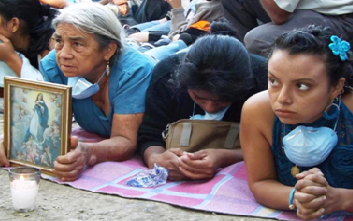 |
| Members of communities in resistance lie down on the street as the police attempt to forcefully evict them (Photo: Prensa Libre) |
GHRC provided support through an ongoing postcard and email campaign that resulted in hundreds of messages to Kappes, Cassiday & Associates, asking for the company to respect the rule of law and to listen to community demands. In December 2012, GHRC wrote a letter in response to the KCA president’s response to GHRC’s urgent action. GHRC urgent actions have also resulted in over 1000 emails to the Guatemalan government demanding that they stop evicting protesters, find a peaceful solution to the conflict and respect community members’ legal rights.
JUNE 12, 2013: Representatives of La Puya met with President Otto Pérez Molina to discuss the ongoing threats against them as well as their continuing rejection of mining activities in their region. Representatives of Kappes, Cassiday and Associates tried to participate in the meeting, but were forced to leave as the members of La Puya insisted that the conversation be between them and their government. As a result of the meeting, President Pérez Molina agreed to a new, independent environmental impact analysis of the proposed mine.
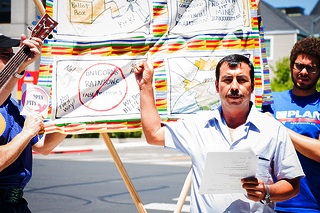 |
| Alvaro Sandoval in “A Tale of Two Communities.” |
JUNE 26, 2013: The Comstock Residents Association from near Reno, Nevada protested against Comstock Mining Incorporated’s (CMI) plan to mine in the Virginia City National Historic Landmark.
With the help of GHRC, Alvaro Sandoval Palencia traveled to Nevada to join the protest and tell the story of La Puya. Through musical street theater, the protesters told “A Tale of Two Communities,” drawing the connections between the imposition of destructive mining in both places.
According to Alvaro “We [at La Puya] are not against progress. We are simply questioning the price that we have to pay for this development. We’re fighting for our rights, which are not respected either by the multinational companies or by the Guatemalan Government.”
The protest received media coverage from The Nevada Appeal, Fox Reno, and NPR.
MARCH 2, 2014: The movement celebrated its two-year anniversary of peaceful resistance.
APRIL 12, 2014: Trucks carrying bulldozers arrived early in the morning, accompanied by a police escort. By the afternoon, 200-300 police officers were present, in an attempt to intimidate members of La Puya. The situation remained tense, but calm, and the machinery was ultimately removed from the site.
MAY 1, 2014: Despite the absence of credible evidence against them, three members La Puya were found guilty of illegal detention, coercion and threats against employees of the stalled gold mining project, El Tambor. The were each given a 9-year jail sentence, though the jail time can be waived if they pay a fine of about $4,212 (a little over a dollar a day for the entirety of their sentence). The three men decided to appeal the sentence.
MAY 23, 2014: After more than two years of peaceful resistance to a gold mine, and repeated calls for dialogue, the communities in resistance of La Puya were violently evicted from the entrance to the project. Hundreds of police used tear gas and flash bombs to remove the women who formed the front lines of the resistance. Over twenty people were injured.
The brave men and women of La Puya are not backing down. They continue to oppose the project and have received overwhelming support from national and international organizations and individuals in solidarity with their struggle in defense of water, life and community wellbeing. They have committed to continuing the peaceful resistance.
MARCH 2, 2015: The movement celebrated its three-year anniversary of peaceful resistance.
MAY 23, 2015: Members of La Puya joined together to commemorate the one-year anniversary of the day that police violently broke up the blockade that the movement had maintained for over two years. Community members also decided to reactivate their peaceful blockade, while they called for a meeting with the president, and had reached an agreement with the police and Human Rights Ombudsman’s Office to protest peacefully for the next 48 hours. Despite the agreement, approximately 300 police officials arrived in the early morning hours on Tuesday, May 26, responding to a complaint filed by the mining company. Though no one was ultimately evicted, a contingent of police remain, and a new police camp has been set up on company land right across from La Puya.
JULY 15, 2015: A Guatemalan court ruled in favor of La Puya, ordering EXMINGUA — the Guatemalan subsidiary of US mining company Kappes, Cassiday & Associates (KCA) — to suspend all activities at the mine until a community consultation is held. The court also ordered the Municipal Council of San Pedro Ayampuc to take action to ensure any construction is stopped within the next 15 days. The ruling was appealed by EXMINGUA, but upheld by Guatemalan courts. Thousands of concerned citizens in the international community sign a petition calling for the company to comply. Despite these efforts, however, the company has continued operations as though nothing has occurred.
OCTOBER 26, 2015: 12 members of the US Congress sent a letter to President Alejandro Maldonado Aguirre to raise concerns about abuses related to the El Tambor gold mine, and to call for KCA and EXMINGUA to promptly halts the illegal operations. The company’s operations continue.
JANUARY 2016: Municipal Authorities in San Pedro Ayampuc carry out administrative precautionary measures to protect affected residents, and block entrance to El Tambor. The administrative measure is challenged by the company.
FEBRUARY 22, 2016: The Guatemalan Supreme Court rules to provisionally suspend KCA’s mining license due to lack of consultation with affected communities. The decision responds to a complaint filed by CALAS in 2014.
